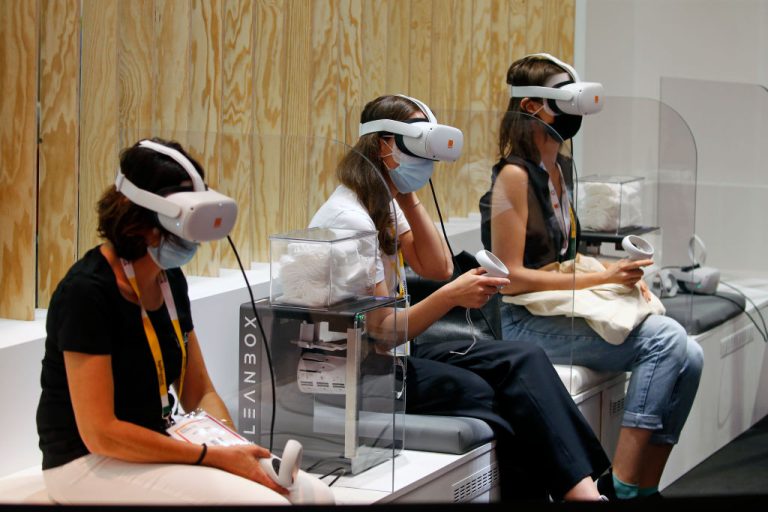A newly published first-of-its-kind study put 18 people in virtual reality for a full 40-hour work week. The results were far from indicating virtual reality has a chance to become a new paradigm of the human living condition.
Two dropped out within hours, while the remaining 16 self-reported and measured negative data points against physical reality in nearly every single category across the board.
Published June 8 on the Cornell University arXiv website, a team of researchers from Universities in Germany and Slovenia, the University of Cambridge, and Microsoft Research sought to examine whether it was viable to have humans do their normal daily work inside of virtual reality over a long period of time.
MORE ON LIVING INSIDE A COMPUTER
- Virtual Reality an ‘Effective Tool’ To Force Consumer Behavior Change: Study
- You’ll Raise Virtual Children in the Metaverse and Pay for the Privilege: AI Expert
- Japanese Startup Builds Electroshock Bracelet to Inflict Pain On Metaverse Users
- Ireland Runs Oil and Electricity Shortage Wargame With Lockdowns, Fuel Control
The team cited multiple shorter-term studies in the preamble, noting that none had gone so far as to attempt to simulate a real world use case yet.
The study divided the 18 participants into two groups, with each working one 8 hour, 5 day work week in physical reality, and the other under the auspices of an Oculus VR headset and a Logitech keyboard with a built-in touchpad.
Success
You are now signed up for our newsletter
Success
Check your email to complete sign up
Of the two participants who immediately dropped out, one male and one female aged 32 and 33, the first “experienced regular migraines and mentioned that the weight of the headset triggered them.”
The second “explained that due to the weight of the headset it was not possible to sit in a relaxed position,” the study stated.
It noted that for the second participant, they also tapped out early because the lack of having access to their usual work environment “reduced motivation and productivity.”
Of the 16 remaining guinea pigs, the mean age was 29. The group was composed of 10 men and 6 women, and “all participants were employees or researchers at a university.”
Subjects were affixed with a heart rate monitor, surveilled by a webcam, and were asked to fill out a questionnaire 5 times a day.
Results showed that the only metric that showed an improvement over physical reality was “Task Load,” a self-reported category, the outcome of which was described as “significantly higher.”
However, users found “Flow,” “Perceived Productivity,” and “System Usability” were all better in physical reality.
Researchers were forced to concede that for Flow, “This result suggests that working in VR did not support participants’ focus and sense of active engagement in their work activity in a better way” compared to reality.
Notably, data showed that the categories “Frustration” and “Negative Affect” were both “significantly higher” in the VR work conditions.
The same was said for “Anxiety” and “Visual Fatigue.”
The category “Wellbeing” also rated “significantly higher” for the physical world.
Participants were interviewed post-mortem. The most common complaints were the weight of the headset, substandard peripheral view, missing the ability to write things down on paper, having to take the headset off to do basic things like eating or drinking, and having to guess what was going on around them in the office.
Specifically, the participants noted they all felt fatigued because they spent more time working on their tasks than they did normally, in many cases because of having a headset bolted to them.
One individual, however, revealed a significant caveat to this proclaimed increased productivity when they were directly quoted as stating, “In VR I had 45 minutes of high performance and then 3 hours of headache.”
The Discussion section elucidated further, “While the self-rated task load in VR was approximately 35% higher compared to [reality], it is still within the 50th percentile of ratings of computer activities.”
Among other drawbacks, some participants reported experiencing visual distortions on their drive home, significant dry eyes, and feeling dizzy and sleepy for hours afterwards.
Additionally, swollen faces and stiff necks and shoulders from wearing the device was commonly reported.
Nonetheless, the researchers concluded they would still like to push forward with ways to transform the traditional and normal way of human life, which has persisted for at least 5,000 years.
“Overall, this study helps laying the groundwork for subsequent research, highlighting current shortcomings and identifying opportunities for improving the experience of working in VR. We hope this work will stimulate further research investigating longer-term productive work in-situ in VR,” the paper concluded.
A dystopian reality
A January article published in Wired used a particularly twisted approach to glorify the push for humans to no longer live in reality, but to instead be trapped in the Metaverse.
The article was titled I Spent Hundreds of Hours Working in VR. Here’s What I Learned, and was subheded with the sentence, “This is how it feels in the future Mark Zuckerberg promised—disembodied and unaware of my surroundings.”
And while this might give headline scrollers and social media snippet parsers the impression that maybe the experience wasn’t so great, the author actually lauded their experience living their work week inside the Immersed app.
Immersed, to speak frankly, comes across as a low resolution and really lame version of the legacy desktop MMO Second Life and a product that’s pretty much on the production quality level of the first Nintendo Wii.
Written in a colloquial style, they open the article stating, “Even as I write this to you, I have Facebook’s Oculus strapped to my face and am in an aptly named app called Immersed. It puts me in this orbiting spaceship where there’s just me, the computer screen in front of me, and—let me look out the window—Ecuador.”
It’s great, he says, because the virtual desktops in the app can be resized.
The manifesto contains some hot takes like, “A month after getting the headset, I gave away my real-world desk.”
And, “The battery lasts only an hour or two by itself, but I’m still deep into cyberpunk…and now I get to live that future by jacking a charging cable right into my face.”
Making the message of the article a little more clear, they state, “It’s all about maximizing productivity.”
And it’s great just how much work he can get done compared to that pesky reality, “It’s true: I get so focused on work, so deep into the zone, that I don’t notice my forehead going numb.”
“Cues like the sun setting on another day are invisible to me, and with no view of the clutter in the meatspace room, I don’t distract myself by getting up to clean something every 20 minutes,” he clarifies.
Then the diatribe gets downright into globalist faction World Economic Forum “You’ll own nothing and be happy” territory.
The author starts an unhinged rant about how he wants “to use the headset in a manner that’s less ‘crush imaginary opponents’ and more ‘corpse pose.’”
So he describes getting an inflatable raft, deploying it in his living room, and laying on top of it with the headset on his face with each hand on a different keyboard.
Where it gets dystopian is when he glorifies how he “has a hoodie pulled over [his] head” and has “covered [himself] in a blanket, leaving only [his] chin exposed,” all “because it lets [him] leave the heat off.”
A great solution for the carbon climate change narrative and mankind’s then-yet-to-begin global energy crises, no doubt.







